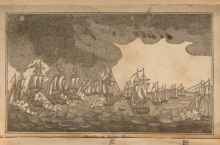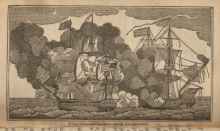Battle of Lake Erie
Description
The Battle of Lake Erie, October 10, 1813 was a major event in the War of 1812. With its many American naval victories (like the one depicted here), the war played a significant role in the development of the United States' national identity (R. Stein, Seascape 27). At least fourteen ships are engaged in battle.
The Constitution and Guerrier
Description
The battle between the Constitution and the Guerrier resulted in an American victory. The prominence of the British and American flags emphasizes not only the nationality of the victor, but also of the defeated. This image depicts a naval battle between two ships.



